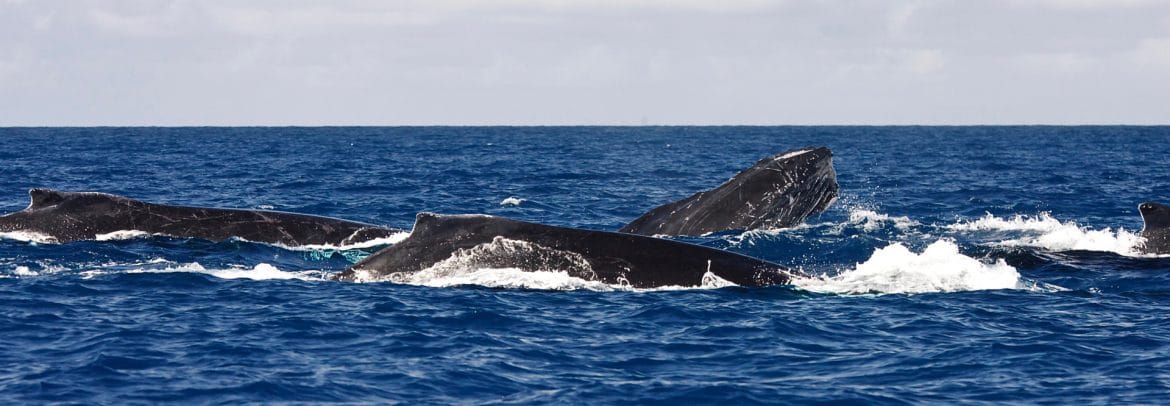- Welcome to Conscious Breath Adventures
Humpback Dads
- Home
- Humpback Whales
- Humpback Dads

Happy Father’s Day from the Silver Bank!
by Cloe Waterfield
In honor of Fathers Day we present eight key characteristics to know about male humpback whales. They are singing, fighting, well endowed, 40 ton loners that are absent fathers, but, as our video shows, can also to be quite sensitive boyfriends.
Some of us may have had similar experiences in the human world?!
These traits have evolved to maximize breeding success so we should first understand a little about how humpback whales reproduce. But also be aware that there is much more to be learned. These animals are incredibly hard to study.
The mating system of humpbacks is described by biologists as polygynous. This Greek word translates as poly = many, gynous = wives, meaning one male to many females.
At breeding time, polygynous species sometimes form associations called leks. These are the animal equivalent of a speed dating session where males display their physical qualities to a large number of females.
Humpbacks are thought to have a marine version of this going on, famously termed a “floating lek”. Males sing, fight and jostle with the hope a female sees their prowess, he wins her favor, and be able to mate to father a calf.
Often in polygynous systems a few dominant males are found to be siring a large proportion of the offspring. Interestingly, studies have shown that this skew is not as strong in humpback whales as in other species. This may be related to their habitat – they are so widely dispersed in the ocean environment.
Some of the uniquely male traits presented below have arisen or are related to this lek-like mating system.
Here are eight traits unique to male humpback whales:
-
They sing
Probably the best known of all humpback whale behaviors is their mysterious singing, which is exclusive to male whales. Members of a population sing varieties of the same song. The songs even change over time.
Because they sing mostly on the breeding grounds it is considered a reproductive strategy; either to attract a mate or communicate territory to other whales.
-
They fight

Witnessing a competitive or rowdy group is one of the most exciting behaviors to see on the breeding grounds. Up to 20 whales can be involved in these lengthy and vicious battles. It is the epitome of testosterone-fueled male bravado and quite a sight to see.
Not all whales fight like humpbacks do. In fact, direct observations of aggression are limited to humpbacks and southern right whales, though other species may also participate in less vigorous competitive behavior.
-
They tend to keep to themselves
On feeding grounds, pairs or small groups of whales are usually found to be females or one male with other females. These can be multi-year friendships, collaborating to feed. This has not been seen in male humpbacks. On the feeding grounds the image of the solitary male whale is more accurate.
However, there are a few reports of males cooperating on breeding grounds: working together within the rowdy groups to displace larger males, or acting as a team to corral a female.
-
They are smaller than the females
Adult males reach 43-46 feet in length (13-14m) while females are larger at up to 52 feet (15-16m). The additional work entailed with growing and nursing a 20 foot baby requires some extra-hefty mommas.
Size and age are also a factors in reproductive tactics employed by male humpback whales. Large, older whales are frequently the dominant aggressors in rowdy groups. Smaller, younger males may forgo that approach in favor of hanging around a female as an escort. These strategies can change over a whale’s lifetime.
-
But they are well endowed

No one has ever seen humpback whales mating. But they do on occasion show their 10 foot long penis. Normally tucked inside a genital fold, males may extend it for various reasons. It’s certainly not a common occurrence but we’ve seen it on the Silver Bank a few times.
-
They are more likely to migrate
Making the long swim between the feeding and breeding grounds is an undertaking. Studies have shown that some females stay behind in colder latitudes on non-calving years. Why put in the effort when you are not planning on having a baby? But for males, they may as well go, as there’s always a chance they could sire a calf. So we tend to see more males than females on the breeding grounds. This imbalance makes females even more of a hot commodity.
-
They are attentive boyfriends
Escorts are male whales hanging around a female and her calf. It is thought that this is something of a low odds tactic to father a calf. Females that have a calf already are less fecund, i.e. able to become pregnant again. But it’s not impossible so males will maintain an ownership position at her side just in case.
It is unusual to see a mother and calf without an escort. They often act in a protective manner, hustling their charges along. Sometimes a challenger appears and witnessing the ensuing stand-off is fascinating.
Work on Pacific humpbacks showed a few instances where escorts one season successfully mated with those same females the next year. This evidence of longer associations with greater relationship complexity is just another reason we find these whales so fascinating.
-
But absent fathers
Male humpbacks play no part in childcare beyond the act of mating. This is typical of polygynous species and animals that form leks. No resources or special habitat is on offer, just a collection of genes giving rise to the male powerhouse, in this case our humpback whales.
Happy Father’s Day to all and we hope your Dad shares all the best traits of the male humpback whale!